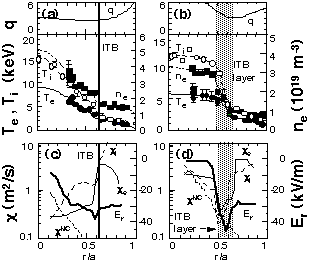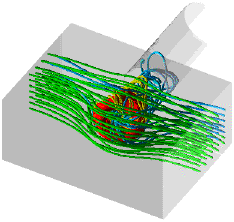III. THEORY AND ANALYSIS
The principal objective of theoretical and analytical studies is to improve the understanding of physics of tokamak plasmas. Remarkable progress was made on the physical understanding of transport phenomena such the internal transport barrier in JT-60U in connection with radial electric field. Progress was also made on the study of stability such as the neoclassical tearing mode and the double tearing. As for divertor plasma, the importance of the thermoelectric instability was shown by using the five point model. The NEXT (Numerical EXperiment of Tokamak) project has been progressed since 1996 in order to research complex physical processes in core plasmas, such as transport and MHD, and in divertor plasma by using recently advanced computer resources.
1. Confinement and Transport
In order to understand the physical mechanism forming the discontinuity of the global drift wave structure near the minimum-q surface, a possible explanation based on the separate structure of sheared slab hi mode near the minimum-q surface has been presented [1-1]. The discontinuity condition was approximately estimated and effects of both the poloidal rotation and the diamagnetic rotation shears were also discussed. Calculation results have a good agreement with the observations in the simulation and suggested that the discontinuous structure of the global drift wave may originate from the excitation of the sheared slab hi mode near the minimum-q surface for the flat q-profile.
The global confinement and the local transport properties of improved core confinement plasmas in JT-60U have been studied in connection with Er shear formation [1-2]. The improved core confinement mode with ITB, the internal transport barrier, is roughly classified into "parabolic" type ITBs and "box" type ITBs (see Fig.III.1-1). In the parabolic type ITB, the gradient of temperature and density change drastically at r=rITB. The temperature and density profiles in the core region rITB are much more peaked than those of peripheral region r>rITB. The parabolic type ITB has the reduced thermal diffusivity, c, in the core region; however, the Er shear, dEr/dr, is not so strong. In the parabolic type ITB, the thin ITB layer within which the temperature and density gradient is very large appears around r=rITB. The width of ITB layer is approximately several times larger than that of ion poloidal Larmor radius. The box type ITB has a very strong Er shear at the ITB layer and the c value decreases to the level of neoclassical transport there. The estimated ExB shearing rate, wExB, becomes almost the same as the linear growth rate of the drift microinstability, gL, at the ITB layer in the box type ITB. Experiments of hot ion mode plasmas during the repetitive L-H-L transition shows that the thermal diffusivity clearly depends on the Er shear and the strong Er shear contributes to the reduced thermal diffusivity.
 |
| Fig.III.1-1 Profiles of safety factor, q, electron temperature, Te,ion temperature, Ti, and electron density in (a) "parabolic type ITB and(b) "box" type ITB. Profiles of experimentally evaluated electron andion thermal diffusivity, ce and ci, neoclassical ion thermal diffusivity, cNC, and radial electric field in (c) "parabolic type ITB and (d) "box"type ITB. (c) and (d) correspond to (a) and (b), respectively (ref.[1-2]). |
Two different transport models, CPT model (canonical profile transport model) [1-3] and SET model (semi empirical transport model), are applied to the JT-60 plasmas [1-4]. The CPT model predicts the bifurcation of the heat flux and the appearance of the ITB layer. The SET model reasonably reproduces the temperature and density profiles of the L-mode and H-mode discharges in JT-60 in a wide range of plasma parameters in the normal shear regime. In the reversed shear regime, the SET model does not describe the steep density and temperature gradient within the ITB layer.
References
[1-1] Li J., et al., "Sheared Slab Instability in Tokamak Plasma with Negative Magnetic Shear", Phys. Plasmas 5, 959 (1998).
[1-2] Shirai H. and JT-60 team, "Reduced Transport and Er Shearing in Improved Confinement Regimes in JT-60U", in Proc. 17th IAEA Fusion Energy Conference (Yokohama, 1998), IAEA-F1-CN-69/EX5/4: to be published in Nucl. Fusion 1999.
[1-3] Dnestrovskij Yu N., Lysenko S.E., Tarasyan K.N., "Improved Confinement Regimes within the Transport Model of Canonical Profiles", Nucl. Fusion 35, 1047 (1995).
[1-4] Dnestrovskij Yu N., Lysenko S.E., (Polevoi A.R.), et al., "Test of Canonical Profiles and Semi Empirical Transport Models against JT-60U Plasmas", in Proc. 17th IAEA Fusion Energy Conference (Yokohama, 1998), IAEA-F1-CN-69/THP2/17: to be published in Nucl. Fusion 1999.
2. Stability
The linear and nonlinear features of a double tearing mode are investigated. The linear growth rate on resistivity h shows g ~ h1/3 for small Dr, a radial distance of two rational surfaces. As Dr increases, the exponent changes from 1/3 to 3/5. The nonlinear study shows that a double tearing mode grows with a linear growth rate and causes a crash when Dr is small. When Dr is large, two islands saturate in the final stage. However, in the intermediate value of Dr, a double tearing mode looks as if it becomes a saturated state once. After a long time it is destabilized nonlinearly by the interaction of two islands and causes the flattening. The phase diagrams for the double tearing mode are also obtained [2-1]. For weakly reversal case, usual tearing mode is possibly unstable and saturated with a finite island size. For strongly reversal case, a tearing mode with a resonant surface in the negative shear region or a double tearing mode becomes linearly unstable. For moderately reversal cases, a double tearing mode becomes unstable and an annular crash occurs for high qmin and the current profile is flatten locally. Core crash, the current profile is flattened to the magnetic axis, occurs for moderate qmin by magnetic reconnections. For lower qmin, the final state is double chains of saturated islands.
Recently, it is shown that the value of the safety factor q is equivalent to 1 at plasma surface during n=1 burst in VDE of JT-60 tokamak. The magnitude of halo current due to m/n=1 external or internal kink modes is investigated by the MHD simulation. It is shown that the vacuum bubble can be formed by m/n=1 kink mode for flat current plasma, which can cause the halo current. The estimated magnitude of halo current can be 50 % of total plasma current for the plasma with the internal inductance of 0.86 [2-2].
Ideal MHD stability of high-elongated JT60-SU plasma is investigated. It is shown that the maximum value of bN is mainly limited by a peeling mode, when the bootstrap current near the plasma surface is enhanced in the H-mode plasma. The triangularity has stabilizing effect on the peeling modes, while the usual free-boundary modes and ideal internal modes are not affected by the triangularity [2-3].
Using the statistical theory, it is shown that the magnetic stretching term in the resistive MHD equations is responsible for the formation of the coherent structures in the 2D MHD turbulence which is related to the transport in the plasma confinement.
In a low collisionality plasma with high bp, large bootstrap fraction and long pulse lengths, neoclassical tearing modes will play a more prominent role in limiting stored energy and degrading confinement. Especially, a weak shear and large pressure gradient enhances the growth of the neoclassical tearing mode. Therefore, effects of the pressure profile and the current profile on the neoclassical tearing mode are investigated, and stabilization by an external local current is discussed. The present stability analysis is based on the saturated island equation (dw/dt = 0), which is derived by the island evolution equation. Results of the analysis show that, for the broad-p (dp/dy /FONT> 0.3(1-y)0.5+0.7) and high li (= 1.2) plasma, the neoclassical tearing mode has better stability where qmin is slightly above one or two. For the broad p and low li (= 0.8) plasma, the higher n mode is more stable. It is also found that a local current drive effectively stabilizes the neoclassical tearing mode. The local current of ~2 % of the total current with a width of 10 % of the minor radius reduces the island width significantly, and increases the stability boundary to the ideal MHD limit. To reduce the island width, localization of the externally driven current is effective. Ray tracing analysis of the electron cyclotron current drive (ECCD) by the fundamental resonance of the ordinary wave at 110 GHz shows localized current drive over a radial region less than 10 % of the minor radius is achievable for JT-60 like configuration with ne0 = 1 エ 1020 m-3, Te0 = 10 keV and R0 = 3.4 m. The current drive efficiency, g = e>R0I/Pinp, is estimated as ~ 0.03 at the half minor radius and an external current of 20 kA (~2 % of 1 MA total current) can be driven by about 1 MW power of EC wave.
References
[2-1] Tuda T., Ishii Y., Kurita G., et al., "Ideal/Resistive Modes Analysis in Reversed Shear Configuration Plasmas", presented at The first general assembly of Asian Plasma and Fusion Association joint with The Third Asia Pacific Plasma Theory Conferenceep. 21-25, 1998, Beijing, China.
[2-2] Kurita G., Yochino R., Neyatani Y., et al., "Halo Current Simulation During VDE in a Tokamak", Presented at Sherwood Theory Conference held at Atlanta USA, March 1999.
[2-3] Kurita G., Nagashima K., Kikuchi M., et al., "Triangularity Effect on Ideal MHD Stability of JT-60SU Plasma", Plasma Phys. Control. Fusion 41, 159 (1999).
3. Divertor
The thermoelectric instability in divertor tokamaks has been studied analytically and numerically by using the five-point model based on scrape-off layer (SOL) and divertor plasmas. To clarify the onset condition of the thermoelectric instability, the linear stability of a symmetric equilibrium of the SOL and divertor plasmas was analyzed by giving an asymmetric perturbation [3-1]. When the divertor plasma temperature Tdiv decreases below a critical temperature, the symmetric equilibrium is found to be unstable due to the thermoelectric instability. It is shown that the critical temperature of the thermoelectric instability depends on the midplane SOL plasma temperature and the divertor radiation loss. Next, the asymmetric equilibrium and its linear stability were investigated [3-2]. When the symmetric equilibrium is unstable, two asymmetric equilibria are obtained. These asymmetric equilibria are stable because the change of sheath potentials and the plasma resistivity suppresses the thermoelectric instability. In an asymmetric equilibrium, the SOL current flows from the higher-Tdiv side to the lower-Tdiv side. The heat flux flowing into the divertor plate of the higher-Tdiv side becomes larger than that of the lower-Tdiv side. The heat flux asymmetry is large for cases in high recycling and low heating power.
References
[3-1] Hayashi N., Takizuka T., et al., "Onset Condition of Thermoelectric Instability in Divertor Tokamaks", Nucl. Fusion 38, 1695 (1998).
[3-2] Hayashi N., Takizuka T., et al., "Numerical Analysis of Thermoelectric Instability in Tokamak Divertor", J. Nucl. Mater. 266-269, 526 (1999).
4. Numerical Experiment of Tokamak (NEXT)
4.1 Development of Computational Algorithm
The development of a compressible MHD code in the torus geometry has been started in order to investigate the mechanism of the collapse in high beta plasmas. The code was constructed by the finite volume method on triangular meshes in the poloidal plane and by the pseudo-spectral method in the toroidal direction. In this code, due to the adoption of the unstructured grid system, the real machine geometry in the poloidal plane will be easily realized without any singularities at the magnetic axis. On the other hand, the high resolution of the toroidal modes is achieved by the benefit of the spectral method. Up to now, the code was inspected for the propagation of linear MHD waves in a uniform plasma.
4.2 Transport and MHD Simulation
It is becoming clear that various improved modes, such as the internal transport barrier (ITB) formed in reversed magnetic shear experiments can be achieved by suppressing such semi-global structure of the toroidal mode which has been obtained in the numerical simulations. We investigate the role of plasma shear rotation and weak/reversed magnetic shear on these semi-global modes by employing our toroidal simulation code together with a non-local theory. From simulations, in addition to the overall reduction of the wave excitation in the entire negative magnetic shear region, we found that the weak or zero magnetic shear which appears near the minimum q (safety factor) surface breaks up toroidal coupling. This leads to a "discontinuity (or gap)" in wave excitation around the q-min surface, leading to the emergence of the transport barrier. The plasma shear rotation which is observed in the experiment enhances the discontinuity so that the performance of the transport barrier is increased [4-1, 4-2].
In order to clarify the nonlinear behavior of the internal collapse, the density gradient effect is studied by the gyro-kinetic nonlinear simulation in a cylindrical plasma. Even when the density gradient is not so large enough to change the process of the full reconnection, the later process is changed due to the self-generated radial electric field which is affected by the fast parallel motion of electrons. This radial field drives the EエB plasma rotation in the ion diamagnetic direction which violates the symmetry of the plasma flow. As a result, the current reconcentration which induces the secondary reconnection is restricted. Therefore, it is a delicate problem whether the minimum safety factor becomes less than unity again [4-3].
In order to investigate the availability of deep fueling in a fusion device by using the compact toroid (CT) injection method, we have carried out the MHD simulation in which the CT is injected into the target magnetized plasma region. It is revealed that magnetic reconnection between the CT magnetic field and the target magnetic field leads to supply of the CT high density plasma into the target region. Also, it is found that the injected CT is decelerated by both the magnetic pressure effect and the magnetic tension effect of the target magnetic field through the plasma pressure.
The boundary layer analysis of the forced magnetic reconnection due to an externally imposed boundary perturbation such as error fields is reformulated by adopting the appropriate asymptotic matching. It yields the correct reconnection process which reflects the effect of the inertia of the plasma in the inner layer exactly [4-4].
Hamilton guiding center theory has been extended to the relativistic electrons. This theory is applied to simulations on collisionless electron motion in stochastic magnetic fields in a tokamak. The simulations have demonstrated that magnetic islands having the widths expected on the major disruption cause the collisionless loss of the relativistic electrons, and that the resultant loss rate is high enough to avoid or to suppress the runaway generation. It is because, for the magnetic fluctuations in the disruption, the loss of the electron confinement due to the breakdown of the toroidal momentum conservation overwhelms the runaway electron confinement due to the phase-averaging effect of relativistic electrons. The simulation results provide a strong support for the JT-60 experiments on the fast plasma shutdown avoiding the runaway generation.
 |
| Fig.III.4-1 The spatial structure ofmagnetic field lines and the CT highdensity plasma when the CT has entered the target region (square)from the injection region (cylinder). |
4.3 Divertor Simulation
Development of simulation codes for scrape-off layer (SOL) and divertor plasmas has been continued. The fluid codes, such as SOLDOR developed in JAERI, employ various physics models, i.e., boundary conditions at the plasma-wall boundary, heat conductivity, viscosity and so on. A particle simulation code PARASOL has been developed to validate these physics models. Magnetic field is given constant, which intersects the divertor plates obliquely. Hot particle source is given in the central region of the SOL plasma. Electron motions are approximated as their guiding-center motions, while ion motions are fully traced. The electrostatic field along the direction normal to the plate is calculated with a usual PIC method. Collisional effects are simulated by a binary collision model. The radial electric field newly introduced providing that it is proportional to the electrostatic potential. The flow pattern becomes asymmetric due to the EエB drift, and the boundary conditions are changed.
References
[4-1] Kishimoto Y., Kim J-Y., et al., "Toroidal mode structure in weak and reversed magnetic shear plasmas and its role in the internal transport barrier", Plasma Phys. Control. Fusion 40A, 663 (1998).
[4-2] Kishimoto Y., Kim J-Y., et al., "Discontinuity Model for Internal Transport Barrier Formation in Reversed Magnetic Shear Plasmas", 17th IAEA Fusion Energy Conference, Yokohama, IAEA-CN-69 / TH 1/2, Japan 19-24, October 1998 : to be published in Nucl. Fusion 1999.
[4-3] Matsumoto T., Tokuda S., Kishimoto Y., et al., "Complex Behavior of Internal Collapse due to Self-generated Radial Electric Field", 9th Toki Conference, P-I-12, Toki, Japan, 7-11, December 1998 : to be published in JPFR Series Vol.2.
[4-4] Ishizawa A. and Hattori Y. "Large Coherent Structure Formation by Magnetic Stretching Term in Two-Dimensional MHD Turbulence", J. Phys. Soc. of Japan 67, 4302 (1998).

